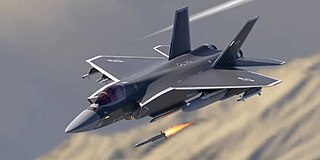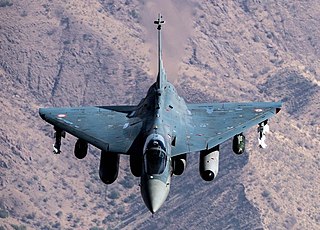
Computer science is the study of computation, information, and automation. Computer science spans theoretical disciplines to applied disciplines.
Software engineering is an engineering approach to software development. A practitioner, called a software engineer, applies the engineering design process to develop software.

The Defence Research and Development Organisation (DRDO) is an agency under the Department of Defence Research and Development in Ministry of Defence of the Government of India, charged with the military's research and development, headquartered in Delhi, India. It was formed in 1958 by the merger of the Technical Development Establishment and the Directorate of Technical Development and Production of the Indian Ordnance Factories with the Defence Science Organisation under the administration of Jawaharlal Nehru. Subsequently, Defence Research & Development Service (DRDS) was constituted in 1979 as a service of Group 'A' Officers / Scientists directly under the administrative control of the Ministry of Defence.

The HAL Tejas is an Indian single-engine, 4.5 generation delta wing multirole combat aircraft designed by the Aeronautical Development Agency (ADA) and manufactured by Hindustan Aeronautics Limited (HAL) for the Indian Air Force (IAF) and Indian Navy. Tejas made its first flight in 2001 and entered into service with the IAF in 2015. In 2003, the aircraft was officially named 'Tejas'. Currently Tejas is the smallest and lightest in its class of supersonic combat aircraft.

The Bhabha Atomic Research Centre (BARC) is India's premier nuclear research facility, headquartered in Trombay, Mumbai, Maharashtra, India. It was founded by Homi Jehangir Bhabha as the Atomic Energy Establishment, Trombay (AEET) in January 1954 as a multidisciplinary research program essential for India's nuclear program. It operates under the Department of Atomic Energy (DAE), which is directly overseen by the Prime Minister of India.

The Advanced Medium Combat Aircraft (AMCA) is an Indian single-seat, twin-engine, all-weather fifth-generation stealth, multirole combat aircraft being developed for the Indian Air Force and the Indian Navy. The Mark-1 variant of the aircraft will be a fifth generation fighter while the Mark-2 variant will have sixth-generation technologies. The aircraft is designed by the Aeronautical Development Agency (ADA) - an aircraft design agency under MoD. A Special Purpose Vehicle (SPV) consisting of ADA, Hindustan Aeronautics Limited (HAL) and a private company is being formed for the development and production of AMCA. In March 2024, the project received approval from India's Cabinet Committee on Security for the prototype development.

The National Institute of Business Management also known as NIBM, is a public business school based in Colombo, Sri Lanka.

The GTRE GTX-35VS Kaveri is an afterburning turbofan project under development by the Gas Turbine Research Establishment (GTRE), a lab under the Defence Research and Development Organisation (DRDO) in Bengaluru, India. An Indian design, the Kaveri was originally intended to power production models of the HAL Tejas Light Combat Aircraft (LCA) developed by Hindustan Aeronautics Limited. However, the Kaveri programme failed to satisfy the necessary technical requirements on time and was officially delinked from the Tejas programme in September 2008.
Advanced Numerical Research and Analysis Group (ANURAG) is a laboratory of the Defence Research and Development Organisation (DRDO). Located in Kanchanbagh, Hyderabad, it is involved in the development of computing solutions for numerical analysis and their use in other DRDO projects.
The Aerial Delivery Research and Development Establishment (ADRDE) is a laboratory of the Indian Defence Research and Development Organisation (DRDO). It is located in Agra, Uttar Pradesh in India. Its research scope includes development of systems for dropping heavy loads, brake parachutes, towed targets, aircraft arrester barriers and aerostats.
Aeronautical Development Establishment is a laboratory of India's Defence Research and Development Organisation. Located in Bangalore, its primary function is research and development in the field of military aviation.

This is a timeline of the development of the HAL Tejas, a light-weight, multirole fighter aircraft manufactured by Hindustan Aeronautics Limited.

The Institute for Space and Defense Electronics (ISDE) is a research facility at Vanderbilt University, a private research university in Nashville, Tennessee. The ISDE is housed in the Department of Electrical Engineering and Computer Science and it is the largest such academic facility in the world.
The Indian Air Force has been undergoing a modernization program to replace and upgrade outdated equipment since the late 1990s to meet modern standards. For that reason, it has started procuring and developing aircraft, weapons, associated technologies, and infrastructures. Some of these programs date back to the late 1980s. The primary focus of current modernization and upgrades is to replace aircraft purchased from the Soviet Union that currently form the backbone of the air force.

The Rudram is a series of supersonic and hypersonic air-to-surface ground attack and anti-radiation missiles in development by the Defence Research and Development Organisation of India. It can be launched from a range of altitudes with large standoff distance for destroying enemy surveillance radars, communication stations and bunkers.

Uttam is a solid-state gallium arsenide (GaAs) based active electronically scanned array (AESA) radar under development by the Electronics and Radar Development Establishment (LRDE), a laboratory of the Indian Defence Research and Development Organisation (DRDO). It is a low probability of intercept radar. It is a liquid cooled AESA radar featuring quad band modules that can be stacked to form a larger unit. This allows the manufacturer to scale the radar to be used in larger aircraft.

Manas Bihari Verma was an Indian aeronautical scientist instrumental in the development of the light combat aircraft, Tejas. In 2018, he was conferred the Padma Sri civilian honour by the President of India. After his retirement he launched Mobile Science Lab aimed at promoting science education in Bihar.

The HAL Tejas Mark 2, or Medium Weight Fighter (MWF), is an Indian single-engine, canard delta wing, multirole combat aircraft designed by the Aeronautical Development Agency (ADA) in collaboration with Aircraft Research and Design Centre (ARDC) of Hindustan Aeronautics Limited (HAL) for the Indian Air Force (IAF). It is a further development of the HAL Tejas, with an elongated airframe, close coupled canards, new sensors, and a more powerful engine.

The HAL Twin Engine Deck Based Fighter (TEDBF) is a canard delta wing, twin-engine, carrier-based, multirole combat aircraft currently under development for the Indian Navy. The TEDBF is being designed and developed by the Aeronautical Development Agency (ADA), and will be manufactured by Hindustan Aeronautics Limited (HAL). The TEDBF is intended to perform a multitude of missions, including air supremacy, air interdiction, anti-access/area denial (A2/AD), anti-ship warfare (ASW) and electronic warfare (EW) missions. The TEDBF is expected to replace the Mikoyan MiG-29K onboard the INS Vikramaditya and the INS Vikrant.















